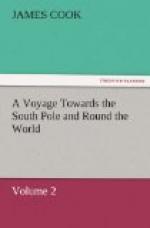1775 January
Next day, being January the 1st, 1775, finding that nothing was wanting but a good harbour to make this a tolerable place for ships to refresh at, whom chance or design, might bring hither, I sent Mr Gilbert over to Staten Land in the cutter to look for one. Appearances promised success in a place opposite the ship. I also sent two other boats for the lions, etc. we had killed the preceding day; and soon after I went myself, and observed the sun’s meridian altitude at the N.E. end of the island, which gave the latitude 54 deg. 40’ 5” S. After shooting a few geese, some other birds, and plentifully supplying ourselves with young shags, we returned on board, laden with sea-lions, sea-bears, etc. The old lions and bears were killed chiefly for the sake of their blubber, or fat, to make oil of; for, except their haslets, which were tolerable, the flesh was too rank to be eaten with any degree of relish. But the young cubs were very palateable, and even the flesh of some of the old lionesses was not much amiss, but that of the old males was abominable. In the afternoon I sent some people on shore to skin and cut off the fat of those which yet remained dead on shore, for we had already more carcases on board than necessary; and I went myself, in another boat, to collect birds. About ten o’clock Mr Gilbert returned from Staten Land, where he found a good port, situated three leagues to the westward of Cape St John, and in the direction of north, a little easterly, from the N.E. end of the eastern island. It may be known by some small islands lying in the entrance. The channel, which is on the east side of these islands, is half a mile broad. The course is in S.W. by S., turning gradually to W. by S. and W. The harbour lies nearly in this last direction; is almost two miles in length; in some places near a mile broad; and hath in it from fifty to ten fathoms water, a bottom of mud and sand. Its shores are covered with wood fit for fuel; and in it are several streams of fresh water. On the islands were sea-lions, etc. and such an innumerable quantity of gulls as to darken the air when disturbed, and almost to suffocate our people with their dung. This they seemed to void in a way of defence, and it stunk worse than assafoetida, or what is commonly called devil’s dung. Our people saw several geese, ducks, and race-horses, which is also a kind of duck. The day on which this port was discovered occasioned my calling it New-Year’s Harbour. It would be more convenient for ships bound to the west, or round Cape Horn, if its situation would permit them to put to sea with an easterly and northerly wind. This inconvenience, however, is of little consequence, since these winds are never known to be of long duration. The southerly and westerly are the prevailing winds, so that a ship never can be detained long in this port.




